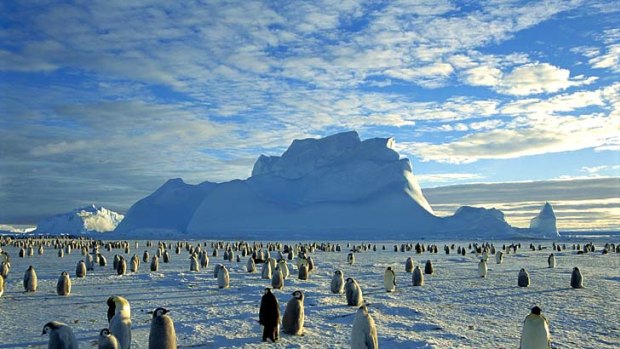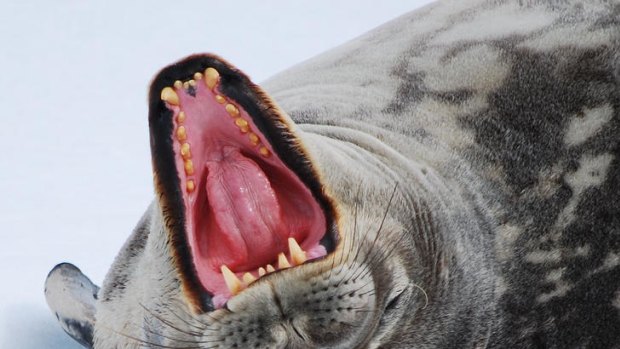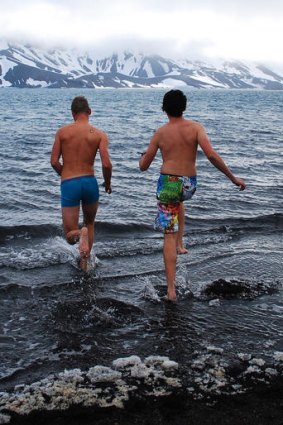
Lucky dip ... an emperor penguin rookery on the Weddell Sea.Credit: Getty Images
Surrounded by penguins and pack ice, Robert Upe hears tales of polar endurance in the Weddell Sea.
Almost a century ago, the polar explorer Ernest Shackleton made a voyage into Antarctica's Weddell Sea, where his wooden sailing ship, Endurance, was trapped and crushed by ice.
I'm in the same sea now, surrounded by pack ice all the way to the horizon.
Shackleton and his men didn't step on land for 497 days. Some of their ordeal was immortalised in the famous black-and-white photographs of Frank Hurley showing the gradual disintegration of the frozen ship and the makeshift camp where they lived miserably on the ice.
As the oak and fir planks of Endurance cracked, she broke into pieces and went to the bottom. The men boarded their lifeboats for a perilous 500-kilometre journey to barren Elephant Island. From there, Shackleton and a handful of others risked another 1300-kilometre lifeboat voyage to South Georgia Island to summon help. Heroic Shackleton eventually saved them all.
Another Antarctic adventurer, Sir Raymond Priestley, sums up Shackleton when he compares him with two other polar legends: Roald Amundsen (the first man to reach the South Pole) and Robert Scott (beaten to the pole by one month by Amundsen): "Give me Scott for scientific method, Amundsen for speed and efficiency but when disaster strikes and all hope is gone, get down on your knees and pray for Shackleton."

A leopard seal.Credit: Robert Upe
Our former research ship, Plancius, meanwhile, is slicing into the white barrier with ease. The sea is calm and the big swells during our two-day crossing of the Drake Passage from our starting point of Ushuaia, at the southern tip of Argentina, have abated.
Many report favourably on this small town that is often dubbed the end of the world. However, I'm left cold. The hotel wants me out at 10am and the departure of the ship is many hours away. The shops are closed all day, it's rainy and one of the few cafes that is open can't serve coffee because the espresso machine is broken.
Many nautical miles south, I'm soothed in the lounge of the Plancius with a gin and tonic with 1000-year-old ice fished out of the water and chipped into glass-size chunks. It's midnight yet light. As I sip, I wonder if this ice was floating here when Endurance came through.

Two bathers take the plunge at Whalers Bay.Credit: Robert Upe
The steel hull of the former Royal Dutch Navy ship pushes forward with the force of diesel engines. It leaves traces of blue paint on the ice, which slowly opens ahead of us in long cracks that provide pathways Shackleton could only dream of. Our Russian captain, Evgeny Levakov, ensures there is always an exit during this small-group World Expeditions voyage.
Adelie penguins resting on the floes look at us like we're space invaders and run and dive with Charlie Chaplin mannerisms into the sea. But belligerent and chubby Weddell seals, which have perhaps feasted on too many cod and krill, are dozy and not so eager to leave. These fatsos sleepily lift their heads and stare at us and sometimes the shadow of the ship is upon them before they decide to give way to our 3175 tonnes.
It's among this pack ice that we see killer whales, also known as orcas, hunting for the plump seals. At one point, there are three pods close to the ship - so many it's hard to know in which direction to point the camera.
At least the killer whales here are the target of our Japanese lenses, not harpoons, which are mainly aimed at Antarctica's population of minke and fin whales.
Some inquisitive killer whales swim alongside the ship as you would expect dolphins to do, tilting their bodies sideways so they can look up to the crowded deck where the cameras are clicking. But mostly, we see them spy-hopping in the middle distance among the pack ice. This is a hunting behaviour that involves the whale surfacing and lifting its massive head out of the water to see if there are seals on the ice floes.
Heaven help any snoozing seals. The whales co-operate in a deadly pod like a wolf pack and will swim at the ice floe with all their might to create a wave to wash the seal into the sea. If that fails, they will also attempt to knock the floe to tilt the seal into the water, or simply rise up and grab it if it is close to the edge.
Antarctica's curious and fearless leopard seal is another efficient polar hunter, second to killer whales in the food chain here. During a shore excursion, some of the passengers watch a leopard seal catch a penguin in the shallows. It's a gruesome sight, with the seal violently shaking the victim and slapping it against the water until it's a bloody mess with its skin coming off.
Following this real-life Attenborough-like scene, stories about leopard seals abound on the ship. They have rarely attacked humans but a scientist snorkelling in Antarctica was killed by one in 2003 when she was grabbed and dragged underwater. Conversely, there is a YouTube video that shows a leopard seal trying to give a diver a penguin that it has caught.
Life aboard the ship, with only 100 passengers, is cordial at first but experiences of puking seas in the Drake Passage, penguin and bird sightings, icebergs rolling over, dolphins on the bow and an on-deck barbecue bond the group further.
We gather in the lounge for drinks or hot cuppas and afternoon cakes and to listen to expert expedition staff talk about their passions.
Polar explorer and climber Bernice Notenboom speaks of her adventures, including her successful 2008 quest to become the first Dutch woman to ski to the South Pole. She reads an extract from her diary:
"Outside minus 31F and wind chill factor — who knows? Boots are frozen, lost sensation in toes, fingertips frigid, goggles iced up. Break down camp with cold fingers, then a pee, butt exposed again."
With the wind howling across the sea, I think how pleased I am to have an en suite in my small-but-cosy two-person cabin.
Henryk Wolski, a Polish sailor and historian, lectures us about the explorers. In 2000 he was part of a four-man team that followed the tracks of Shackleton, using a replica of Shackleton's lifeboat, James Caird. They sailed from the Antarctic continent via Elephant Island to South Georgia. Following the landing, Wolski and co. trekked across South Georgia, like Shackleton did in his desperate bid to find help.
There's also James Cresswell, a geologist and specialist in climate change, and Mick Brown, a naturalist and bird expert, among others.
Outside, during our Zodiac landings, there is penguin entertainment. We step ashore at least once a day, deposited next to rookeries of thousands of nesting penguins as well as seals and sea birds such as skuas, storm petrels, albatross and terns.
The bird enthusiasts among the passengers are delighted at the lists they're ticking off. The excitement of landing at Paulet Island, with a million pairs of Adelie penguins, is unbridled.
We see the eggs of the nesting penguins and opportunistic skuas hanging around to try to grab them. We see penguins bringing pebbles to their mates to fortify their nests. We see chicks that have just hatched.
During the voyage there are also sightings of macaroni, chinstrap, gentoo and king penguins among others but most adulation is reserved for the rare emperor penguin.
During one Zodiac excursion among icebergs and pack ice, a lone emperor penguin is found on a floe. It turns into a paparazzi session and this bemused creature becomes the star of the voyage, probably more photographed than a Hollywood celebrity taking a walk down the red carpet.
As word of the sighting spreads on the radio, Zodiacs close in from all directions for a glimpse of the loner. As our expedition leader, Delphine Aures, points out, "Very few people ever get to see one of these supreme birds in the wild."
Each Zodiac carries 10 passengers and when ferried ashore we dress in warm layers and waterproofs and regulation boots, which are hosed down, scrubbed and disinfected each time to avoid contamination of the environment. We keep an honourable distance from the wildlife, so even with the paparazzi frenzy the emperor penguin is not fazed.
One of the landings is at Argentina's Esperanza Base. As I stumble ashore over chunks of ice and slippery rocks I meet some of the Argentinians who have voluntarily been posted here for the past year. There are soldiers, scientists, mothers and children who have endured months of darkness and the harshest weather. An Argentinian first lieutenant says at the height of winter they were lashed by winds of 240km/h and snap frozen by subzero temperatures with a wind chill so fierce it could freeze your nose off.
The thaw has begun (though we still need thermals, gloves and woollen hats) and the pack ice that has encased this outpost at Hope Bay is breaking up. We are the second ship in several months to get through the ice, the first visiting just days earlier. More tourist ships will arrive soon to relieve some of the tedium of living in a collection of red huts strewn across a jumble of ankle-twisting rocks, snow and ice. The huts are tethered by wires so they don't blow away and the colonists are tethered by geography. They have a continent of open space at their feet but, somehow, claustrophobia lurks.
The welcoming Argentinians are in thrall of the fresh bananas we have; we are in thrall of this community of 60 people living alongside an off-limits rookery of 100,000 Adelie penguins.
As remote as it is, surprisingly there is mobile-phone reception and my line home to Australia is as clear as the ice that bobs in the water.
There is a small school here, a community mess hall where residents gather for meals, a chapel, a museum with Antarctic relics and a postal service from where I send a postcard home*, stamped November 27. As well, the Argentinians process our passports with an unofficial Antarctic stamp.
There is a stone shelter near the sea, marking the place where three Swedish explorers were stranded during the winter of 1903. Gunnar Andersson, Lieutenant S. A. Duse and Toralf Grunden were put ashore for a short-term exploration but their ship failed to return because, like Shackleton, it was crushed by ice and sank. The bedraggled trio trekked 200 kilometres the next summer to find rescue and were so black from soot that, at first, the rescuers thought they were indigenous habitants of Antarctica who had never been seen before.
There are still supplications inscribed by the men on the rocks in the shelter where they prayed and where they ate 700 penguins during their long and lonely winter.
Near their stone sanctuary is a small hand-painted Argentinian flag with the triband of light blue, white and light blue. It doesn't flutter because it is cold steel but the patriotism of the base is unmistakable. This existence of the base, according to some seasoned expeditioners on our ship, is more to do with territorial claims than scientific research.
There is a "laboratorio biologia and geologia" in what looks like a shipping container but it appears so insignificant that the charge of territorial jostling seems to hold at least some credibility. As well, the first person to be born in Antarctica was Emilio Marcos Palma in 1978, whose Argentinian mother was sent to the base when she was seven months' pregnant.
(Several countries have made territorial claims to Antarctica but no single country controls any part of the continent while it continues to be governed by the Antarctic Treaty.)
Esperanza Base is the only place we see others in Antarctica. We also anchor at desolate Deception Island, a horseshoe-shaped volcanic caldera that last erupted in 1969 and which has decaying signs of habitation.
Cruising into the caldera, fringed by glaciers and mountains, requires concentration by the captain. The entrance is just 230 metres wide and there is a large submerged rock that can rip open the hull. We land at Whalers Bay, where there are ruins to explore from an abandoned whaling station later used for scientific research.
There are rusty iron boilers, wooden buildings falling apart, graves and machinery and boat wrecks that have almost been covered by the volcanic debris. Sea water freezes at minus 2 degrees and we figure the water here is about minus 1. There is ice on the shore but two passengers take the plunge into the frigid sea to say they have swum in Antarctica, even if it is the most fleeting of dips.
There is no swimming when we land at Elephant Island, where Shackleton and his men stepped ashore after their 479 days on ice. The shore is full of sleeping elephant seals and the sea is heaving. Getting out of the Zodiacs needs precise timing. One passenger falls in but we have thermals and waterproofs and a heated ship anchored close by. It would have been far worse for Shackleton.
*Still waiting for it.
Robert Upe travelled courtesy of LAN Airlines and World Expeditions.
FAST FACTS
Getting there
LAN Airlines has a fare to Ushuaia, Argentina, from Sydney and Melbourne for about $2575 low-season return including tax. Fly from Sydney to Santiago (about 16hr including transit time in Auckland), then to Buenos Aires (about 3hr), then to Ushuaia (3hr 45min); see lan.com. Melbourne passengers fly Qantas to Sydney to connect and back from Auckland. Australians don't require a visa for a stay of up to 90 days but must pay a reciprocity fee of $US100 ($94) on arrival.
Cruising there
World Expeditions has a range of trips to Antarctica, including the 11-day "In Search of the Emperor Penguin", a modified version of the trip described. It departs from Ushuaia and heads to the Weddell Sea on a new ship, Ortelius, on November 14, November 24 and December 4. It costs from $US11,150 a person, four share, including meals, lectures and guided Zodiac excursions. Phone 1300 720 000; see worldexpeditions.com.
More information
See antarcticguide.com.
Sign up for the Traveller Deals newsletter
Get exclusive travel deals delivered straight to your inbox. Sign up now.